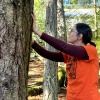
Heavy Equipment Operator Instructor (HEOI) Brandon Lindsay works with a student on a simulator while HEOI Kevin Levins works with another simulator.
November 27, 2018 - 3:45am
By Jenn McGarrigle
From developing new programs to meet community needs, to enhancing experiential learning opportunities and researching ways to engage with non-traditional learners in building programs, the Faculty of Trades and Applied Technology is busy working through its 2017-22 strategic plan.
The Faculty is made up of 16 different departments and offers Trades Foundation, Apprenticeship and Applied Technology programs in heavy industry, construction and service industry trades. Some of these programs received a major boost with the $20-million Marine, Automotive and Trades Complex expansion and redevelopment project. But that’s not the only thing buzzing around TAT. Faculty are also busy developing new programming, evaluating existing programs and developing new recruitment strategies.
For example, the Faculty acquired eight heavy equipment/forestry simulators, housed in two truck-and-trailer units to transport them wherever they are needed. Since then, faculty have been taking the trailers to remote communities and First Nations communities, creating opportunities for students who may not have access to training otherwise.
Another exciting development is the new Fundamentals of Forest Harvesting Practices program, a 12-week program that provides new forestry workers with the foundational skills and knowledge required to work safely, productively and sustainably in a harvesting environment. Based on the BC Forest Safety Council’s identified core competencies, the first cohort of 12 students trained in the North Vancouver Island community of Woss from April to July. Before the program even finished, 10 of them had already secured employment in the industry.
Paul Mottershead, Associate Dean, says the Regional District of Mount Waddington called VIU to the table to provide this program because smaller communities are facing a crisis – as workers retire, there is a great need for young workers to replace them.
“This is the first time anyone has ever done this type of training,” says Mottershead. “Our plan is to offer two more Fundamentals courses in 2019.”
Experiential learning is a huge part of many trades and applied technology programs at VIU – it’s not uncommon to see students divide their time 30/70 between classroom theory and hands-on practice. For example, the carpentry program partners with Habitat 4 Humanity to build houses for the families they help; and in the Hairdressing program, students operate a service salon with real customers. These types of opportunities have been increasing in recent years and more partnerships are sought all the time to advance experiential learning opportunities and ensure students are getting up-to-date, relevant training that reflects industry standards.
Recently, new opportunities for faculty have led to some interesting insights. For example, VIU is helping a Kenyan polytechnic college redesign their Building Technology programs – a project faculty hope will add to their ability to bring intercultural perspectives into their teachings.
Another goal in the strategic plan is to develop a strategy that creates awareness of the building trades as a viable career option for non-traditional learners such as women, and Indigenous and international students. Glynis Steen, Dean of TAT, says faculty are looking at what might make these trades more attractive to these populations, and hope to have a strategy in place by 2022 that is integrated with their overall recruitment strategy. One option they are looking into is working with school districts and local Indigenous communities to deliver trade sampler programs developed specifically for female and Indigenous students.
Tags: Teaching and Learning






